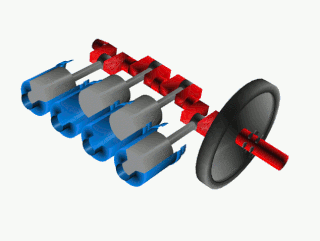
A crankshaft is a shaft driven by a crank mechanism consisting of a series of cranks and crankpins to which the connecting rods of an engine is attached. It is a mechanical part able to perform a conversion between reciprocating motion and rotational motion. In a reciprocating engine, it translates reciprocating motion of the piston into rotational motion, whereas in a reciprocating compressor, it converts the rotational motion into reciprocating motion. In order to do the conversion between two motions, the crankshaft has "crank throws" or "crankpins", additional bearing surfaces whose axis is offset from that of the crank, to which the "big ends" of the connecting rods from each cylinder attach.

The D-subminiature or D-sub is a common type of electrical connector. They are named for their characteristic D-shaped metal shield. When they were introduced, D-subs were among the smallest connectors used on computer systems.

The Apple Display Connector (ADC) is a proprietary modification of the DVI connector that combines analog and digital video signals, USB, and power all in one cable. It was used in later versions of the Apple Studio Display, including the final 17" CRT model, and most versions of the widescreen Apple Cinema Display, after which Apple adopted standard DVI connectors on later models.

High-Definition Multimedia Interface (HDMI) is a proprietary audio/video interface for transmitting uncompressed video data and compressed or uncompressed digital audio data from an HDMI-compliant source device, such as a display controller, to a compatible computer monitor, video projector, digital television, or digital audio device. HDMI is a digital replacement for analog video standards.

The Apple Cinema Display is a line of flat-panel computer monitors developed and sold by Apple Inc. between 1999 and 2011. It was initially sold alongside the older line of Studio Displays, but eventually replaced them. Apple offered 20, 22, 23, 24, 27 and 30-inch sizes, with the last model being a 27-inch size with LED backlighting.

The firing order of an internal combustion engine is the sequence of ignition for the cylinders.

The Apple Interactive Television Box (AITB) is a television set-top box developed by Apple Computer in partnership with a number of global telecommunications firms, including British Telecom and Belgacom. Prototypes of the unit were deployed at large test markets in parts of the United States and Europe in 1994 and 1995, but the product was canceled shortly thereafter, and was never mass-produced or marketed.
Engine balance refers to how the forces are balanced within an internal combustion engine or steam engine. The most commonly used terms are primary balance and secondary balance. First-order balance and second-order balance are also used. Unbalanced forces within the engine can lead to vibrations.

Apple TV is a digital media player and microconsole that is developed and marketed by Apple Inc. It is a small network appliance hardware that plays received media data such as video and audio to a television set or external display. An HDMI-compliant source device, it has to be connected to an enhanced-definition or high-definition widescreen television through an HDMI cable to function.
Comparison of the Java and .NET platforms.

HD DVD is a discontinued high-density optical disc format for storing data and playback of high-definition video. Supported principally by Toshiba, HD DVD was envisioned to be the successor to the standard DVD format.
Advanced Content provides interactivity in the HD DVD optical disc format.

The Apple AudioVision 14 Display is a 14-inch Trinitron display that was manufactured by Apple Inc. This display is unique because it is the only display ever to use the HDI-45 connector, capable of transferring video to the screen, video capture input from an S-Video source, audio output, audio input, and Apple Desktop Bus (ADB) all through one cable. The monitor also has a built-in microphone. The included driver adds the following specialized functionality to the Sound control panel:
The Apple Intermediate Codec is a high-quality 8-bit 4:2:0 video codec used mainly as a less processor-intensive way of working with long-GOP MPEG-2 footage such as HDV. It is recommended for use with all HD workflows in Final Cut Express, iMovie, and until Final Cut Pro version 5. The Apple Intermediate Codec abbreviated AIC is designed by Apple Inc. to be an intermediate format in an HDV and AVCHD workflow. It features high performance and quality, being less processor intensive to work with than other editing formats. Unlike native MPEG-2 based HDV - and similar to the standard-definition DV codec - the Apple Intermediate Codec does not use temporal compression, enabling every frame to be decoded immediately without decoding other frames. As a result of this, the Apple Intermediate Codec takes three to four times more space than HDV.

The Macintosh External Disk Drive is the original model in a series of external 3+1⁄2-inch floppy disk drives manufactured and sold by Apple Computer exclusively for the Macintosh series of computers introduced in January 1984. Later, Apple would unify their external drives to work cross-platform between the Macintosh and Apple II product lines, dropping the name "Macintosh" from the drives. Though Apple had been producing external floppy disk drives prior to 1984, they were exclusively developed for the Apple II, III and Lisa computers using the industry standard 5+1⁄4-inch flexible disk format. The Macintosh external drives were the first to widely introduce Sony's new 3+1⁄2-inch rigid disk standard commercially and throughout their product line. Apple produced only one external 3+1⁄2-inch drive exclusively for use with the Apple II series called the Apple UniDisk 3.5.

The iPad is a brand of iOS and iPadOS-based tablet computers that are developed by Apple Inc. The iPad was conceived before the related iPhone but the iPhone was developed and released first. Speculation about the development, operating system, and release of the original iPad began in 2002 prior to its introduction on January 20, 2010. The iPad range consists of the original iPad lineup and the flagship products iPad Mini, iPad Air, and iPad Pro.

Toyota Entune is an integrated multimedia navigation and telematics system for Toyota automobiles, providing satellite-based information on traffic, weather, sports scores, stocks, and fuel prices via subscription through SiriusXM. When connected to a compatible cellular phone running the Entune app, via radio or USB cable, the system provides a browser and other apps, including those from music services such as iHeartRadio, Pandora and XM Satellite Radio. The cell phone app has iOS, Android, and Blackberry versions; to use this feature, a cell phone data plan is required. The system can be controlled with voice recognition, and may include the “Safety Connect” personalization system.

The iPhone 7 and iPhone 7 Plus are smartphones designed, developed, and marketed by Apple Inc. They are the tenth generation of the iPhone. They were announced on September 7, 2016, at the Bill Graham Civic Auditorium in San Francisco by Apple CEO Tim Cook, and were released on September 16, 2016, succeeding the iPhone 6, iPhone 6 Plus, iPhone 6S and iPhone 6S Plus as the flagship devices in the iPhone series. Apple also released the iPhone 7 and iPhone 7 Plus in numerous countries worldwide throughout September and October 2016. They were succeeded as flagship devices by the iPhone 8 and iPhone 8 Plus on September 22, 2017.












